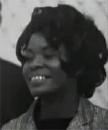 If I had the opportunity to replay video footage of my entire life (a horrifying prospect, for those who haven’t seen the Albert Brooks movie Defending Your Life), I could pinpoint the precise moment where music became more than just background noise and started to become a passionate life force. While still in elementary school, I stumbled upon a free music festival in my native Chicago, and noticed an unfamiliar name on the stage sign: Koko Taylor and her Blues Machine.
If I had the opportunity to replay video footage of my entire life (a horrifying prospect, for those who haven’t seen the Albert Brooks movie Defending Your Life), I could pinpoint the precise moment where music became more than just background noise and started to become a passionate life force. While still in elementary school, I stumbled upon a free music festival in my native Chicago, and noticed an unfamiliar name on the stage sign: Koko Taylor and her Blues Machine.
On first glance, I could tell Ms. Taylor was roughly old enough to be my mom–that is, if my mom were half a foot taller, the daughter of Tennessee sharecroppers, and dressed in a glittery evening gown. But when she started singing, I entered a different world, never to return. I’d had a few experiences with live music before, including an encounter with a lame local band called Styx, but nothing in the world I knew prepared me for her complete command of the stage, and for a voice that sounded like it had been raised on a diet of sandpaper and velvet, with an extra helping of sandpaper. The first song I remember hearing–I’d later learn it was a cover of Irma Thomas‘s first big hit, the self-explanatory “You Can Have My Husband (But Don’t Mess with My Man)”–was inappropriate grade-school listening at its finest, especially in its recounting of the two male rivals’ mismatched sample menus (husband serves red beans and rice, man “keeps me in steaks,” and this being the midwest, red meat wins in a landslide).
The truly magic moment came later in the show, when Koko ripped into her signature song, “Wang Dang Doodle,” with a force that sounded like it could travel halfway to Wisconsin. Koko’s tornado of a voice made a perfect match for one of of unsung hero Willie Dixon‘s many brilliant compositions (Dixon himself reportedly thought the song was a silly trifle, but that’s why we don’t ask artists to critique their own songs). Topical songs and complicated poetic songs will come and go, but “Wang Dang Doodle” is timeless. I think of it as a classic work of Chicago architecture, in which form follows function without a wasted line or note. Deceptively simple, “Doodle” works simultaneously as cryptic secret code, melodramatic short story, risque nursery rhyme, and kick-ass empowerment anthem (to this day, when I have moments of doubt, I think to myself, “I’m gonna break out all the windows, I’m gonna kick down all the doors”).
“Wang Dang Doodle” has been covered by everyone from Howlin’ Wolf to P.J. Harvey, but Taylor’s remains the best. (In the 1967 version below, Taylor gets great accompaniment from harmonica virtuoso Little Walter, and eleven-fingered guitarist Hound Dog Taylor.) This week, obituaries reported that Koko Taylor passed away, that she won a bunch of awards, and that some called her the queen of the blues. But none of that would convey why, when I broke that news to my kids, all of us started crying. Someday when they’re older, they’ll have moments of doubt and need to find the strength to kick down all the doors. And I hope I’m still there to sing “Wang Dang Doodle” for them, all night long.
Koko Taylor, “Wang Dang Doodle”
I discovered this song in the early 80s, tucked away on an LP I bought on a whim – a live version from some blues festival. It sounded more polished than this version, but I loved it anyway. Great to hear this earlier version – it’s grittier, toothier. She will be missed.
Styx isn’t lame, but you are an idiot. Give you small kudos for recognizing the genius of Ms.Taylor and Mr. Dixon. Who loved Styx btw!
Thanks for your opinion, Liz. I’m not surprised to hear Taylor and Dixon described as fond of Styx; they traveled in some of the same Chicago circles. Koko Taylor’s daughter went to the same high school as James Young. Here are clips of Koko performing with Styx:
http://www.thedeependwithnickmichaels.com/videos.html
http://www.youtube.com/watch?v=7LEyLUzLgtw
Styx also deserves credit for doing some good work on behalf of Willie Dixon’s Blues Heaven Foundation, which others can support at this site:
http://bluesheaven.com/